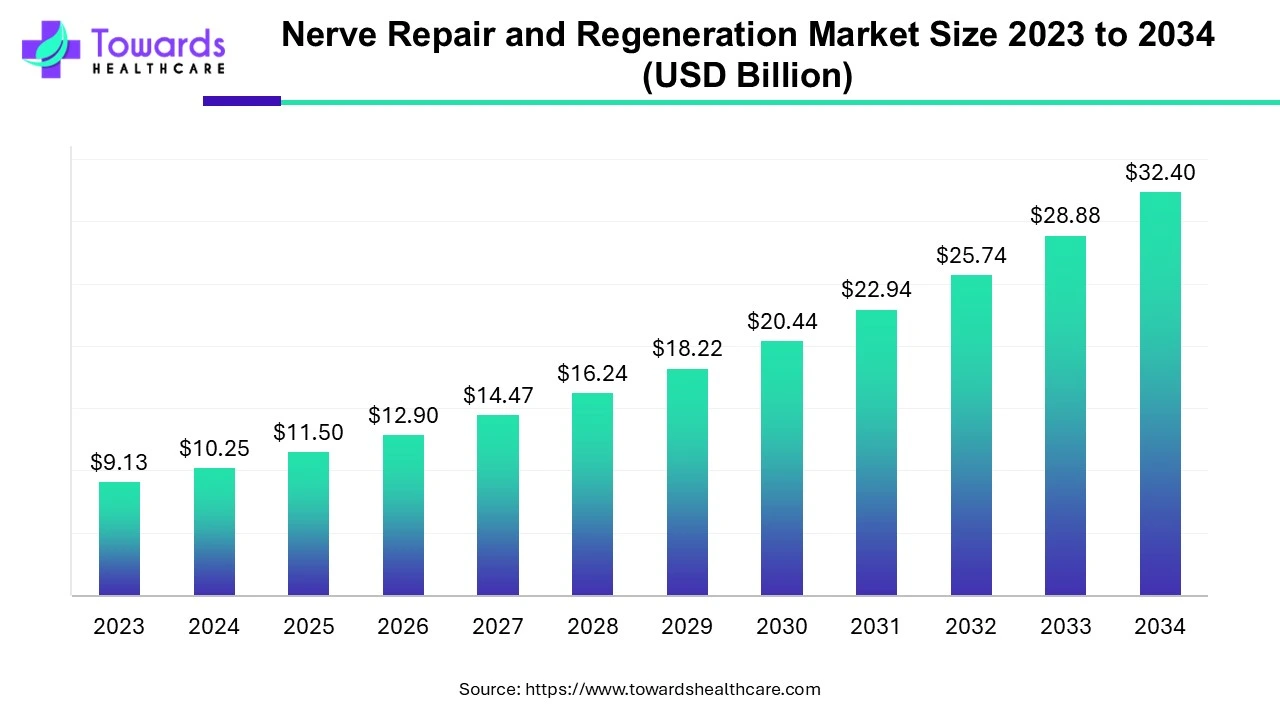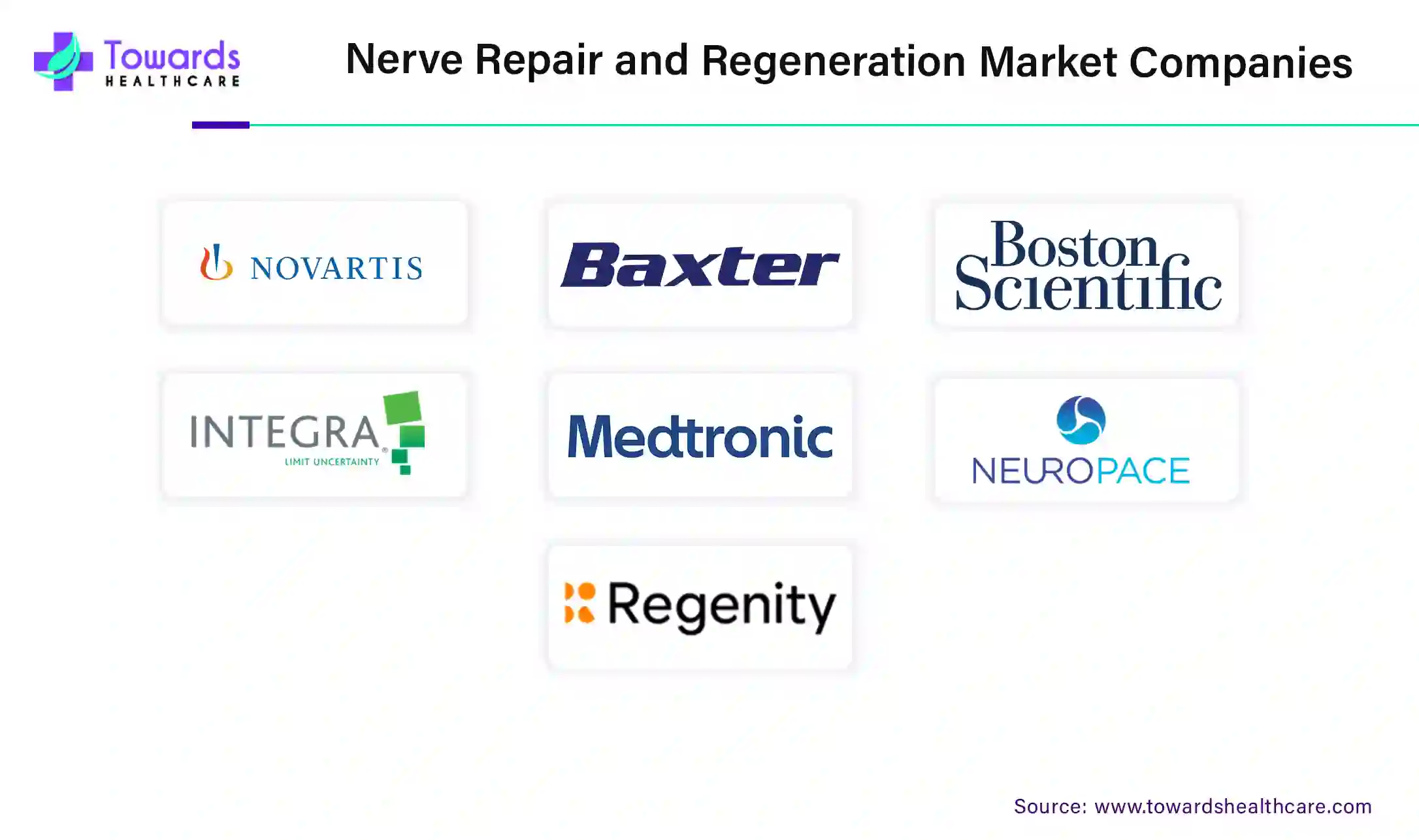March 2025


Principal Consultant

Reviewed By
The global nerve repair and regeneration market size is calculated at USD 10.25 billion in 2024, grew to USD 11.5 billion in 2025, and is projected to reach around USD 32.4 billion by 2034. The market is expanding at a CAGR of 12.2% between 2024 and 2034. The rising incidences of neurological disorders, technological advancements, and increasing investments drive the market.

Nerve repair and regeneration is an ideal therapy for nerve injury to improve nerve reinnervation and electrophysiological functionality. Accidents, falls, sports, chronic disorders, surgery, or trauma can cause central or peripheral nervous system injuries. There are three types of peripheral nervous system injuries: neuropraxia, axonotmesis, and neurotmesis. Peripheral neurons have a different lining, or sheath, made up of Schwann cells. Transplanted Schwann cells can help damaged peripheral nerves regenerate and restore function. Nerve repair and regeneration for nerves can be done using surgical procedures such as direct nerve repair, nerve graft, or nerve transfer.
The rising incidences of peripheral nerve injuries increase the need for nerve repair and regeneration therapy, thereby potentiating the market. Technological advancements can also favor market growth with innovative techniques to improve treatment efficiency. The market is also driven by increasing awareness about mental illness and its effective cure.
Artificial intelligence (AI) has immense potential to revolutionize the market through the latest innovations. AI can be used to assess peripheral nerve injury and repair effectively and aid in developing novel research methods and tools for nerve regeneration. AI can predict the pathological manifestations of the peripheral nervous system and explore better therapeutic outcomes. This can streamline the entire research process, providing cost-effective solutions. Artificial neural networks (ANN) can provide real-time data on the neural regeneration within the body. AI can also identify and quantitatively assess the morphology and structure of neurons via imaging techniques. Additionally, AI-based robotic systems can help guide neuronal surgeries, thereby enhancing surgeon’s precision. Furthermore, the advent of 3D bioprinting technology transforms the way nerve conduits and scaffolds are made for nerve regeneration. 3D-printing technology results in the production of customized scaffolds and enhanced efficiency. Hence, all these applications make AI a suitable factor to advance nerve repair and regeneration.
Rising Nerve Damage: The major driver of the nerve repair and regeneration market is the rising incidences and prevalence of peripheral nerve injuries (PNI). Peripheral neuropathy is a condition that affects the nerves outside the brain or spinal cord. It is estimated that around 13 to 23 people per 100,000 population suffer from PNI. Some common examples of PNI include carpal tunnel syndrome, diabetic neuropathy, ulnar nerve compression, peroneal nerve compression, brachial plexus injury, and peripheral nerve tumors. Carpal tunnel syndrome is the most common condition, constituting 90% of all neuropathy cases. On the other hand, diabetic neuropathy is commonly caused in patients with type 2 diabetes mellitus (T2DM). It is reported that 10-15% of newly diagnosed T2DM patients have diabetic neuropathy, and the prevalence can increase to 50% of patients with more than 10 years of T2DM. Spontaneous nerve regeneration is very slow, generally at a rate of 1 inch per month. Hence, nerve repair and regeneration therapy are required for faster recovery.
High Cost and Lack of Skilled Professionals: The major challenge of the market is the high cost of nerve repair and regeneration therapy. The average cost of the therapy ranges from $4,000 to $50,000 depending on the type of treatment, thereby limiting the affordability of many people from lower- and middle-income families. Another major challenge of the market is the lack of skilled professionals. This is a major issue, especially in LMICs having lack of suitable facilities.
Regenerative Medicine: The increasing awareness and need for regenerative medicines like stem cells provide a better treatment alternative for neurological disorders. Stem cells have the potential to differentiate into Schwann-like nerve cells and promote nerve regeneration. Stem cells derived from numerous locations are used for nerve regeneration therapy. Several scientists and clinicians infuse these stem cells into scaffolds such as nerve conduits to support regeneration. However, more detailed knowledge about suitable stem cell sources, dosage, and delivery methods for treating different types of neuropathy is required. The ongoing stem cell research aims to identify potential applications of stem cells in neurological disorders and increase investments in cell and gene therapy products to promote nerve repair and regeneration market growth.
By product, the neurostimulation and neuromodulation devices segment registered its dominance over the global nerve repair and regeneration market in 2023. Neurostimulation devices can stimulate a response by passing signals, which can also result in chronic pain relief. It delivers electrical or pharmaceutical agents directly to the target area. The most common application is deep brain stimulation for Parkinson’s disease. The widespread applications of these devices, technological advancements, and significant ongoing improvements in biotechnology boost the segment’s growth. Recent innovations in neuromodulation devices eliminate the need for surgical intervention, i.e., they are non-invasive and customizable.
By product, the biomaterials segment is expected to grow at the fastest rate in the nerve repair and regeneration market during the forecast period. Biomaterials are natural products that support nerve repair and regeneration. Some examples of biomaterials include collagen, hyaluronic acid, chitosan, alginate, gelatin, fibrin, etc. They are used as a drug delivery vehicle for cell and gene therapy products, build scaffolds to carry cells, and as medications to achieve nerve regeneration. The rising demand for natural products due to fewer side effects and lesser toxicity potentiates the segment’s growth.
For instance,
By surgery, the neurostimulation and neuromodulation surgeries segment led the global nerve repair and regeneration market in 2023 and is anticipated to grow with the highest CAGR in the market during the studied years. Neuromodulation surgeries involve using electrical currents or pharmaceutical agents to stimulate peripheral nerves. These surgeries are performed when other treatment regimens are ineffective. It is estimated that around 230,000 neuromodulation surgeries are performed every year globally. Recent improvements in surgical procedures and technological advancements augment the segment’s growth.
North America held the largest share of the nerve repair and regeneration market in 2023. The increasing incidences of peripheral nerve injury, technological advancements, and advanced healthcare infrastructure drive the market. It is estimated that more than half a million Americans suffer from peripheral nerve injuries requiring surgical treatments, accounting for 900,000 repair procedures annually. In the US, around 239,873 neuromodulation procedures were performed in 2022. The market is also driven by state-of-the-art research and development facilities and increasing investments & collaborations. Several government organizations, like the National Institute of Neurological Disorders and Stroke (NINDS) and the Centers for Disease Control and Prevention (CDC), promote research on neurological disorders. In 2022, NINDS invested approximately $2.5 million in research projects. Even the Canadian government supports research on neurological disorders by funding organizations. Budget 2024 announced renewed funding to the Brain Canada Foundation of $80 million over four years.
Asia-Pacific is anticipated to grow at the fastest rate in the nerve repair and regeneration market during the forecast period. The rising prevalence of chronic disorders, increasing geriatric population, growing demand for cell and gene therapy products, and increasing investments & collaborations drive the market. The rapid growth and increasing neurology clinics augment the market growth. The total number of neuromodulation procedures performed in China in 2022 was 15,475. While in India and Japan, 10,887 and 11,334 surgeries were performed in 2022, respectively. The growing research and development activities and the increasing number of clinical trials also boost the market. The government organizations also provide funding to support nerve repair research. The Chinese government recently launched the China Brain Project (CBP) with a budget of $746 million to strengthen neuroscience in China.

Paul Anderson, Managing Director, Orthocell Ltd., reported the June quarter revenue of $1.84 million, an increase of 14.4% from the previous quarter and a 10% increase from last year. He said that the surge in revenue was due to Orthocell’s market-leading products Striate+, a non-invasive treatment for dental bone regeneration, and Remplir, a game-changing solution for people with damaged nerves or peripheral nerve pain.
By Product
By Surgery
By Region
March 2025
March 2025
March 2025
March 2025